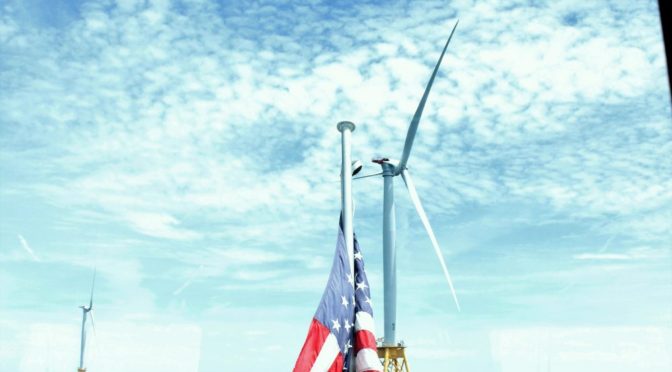Wind energy pricing remains attractive, according to an annual report released by the U.S. Department of Energy and prepared by Lawrence Berkeley National Laboratory (Berkeley Lab). At an average of around 2 cents per kilowatt-hour (kWh), prices offered by newly built wind projects in the United States are being driven lower by technology advancements and cost reductions.
“Wind energy prices – particularly in the central United States, and supported by federal tax incentives – remain at all-time lows, with utilities and corporate buyers selecting wind as a low-cost option,” said Berkeley Lab Senior Scientist Ryan Wiser of the Electricity Markets & Policy Group.
Key findings from the U.S. Department of Energy’s Wind Technologies Market Report include:
- Wind power capacity additions continued at a rapid pace in 2017. Nationwide, wind power capacity additions equaled 7,017 megawatts (MW) in 2017, with $11 billion invested in new plants. Wind power constituted 25 percent of all U.S. generation capacity additions in 2017. Wind energy contributed 6.3 percent of the nation’s electricity supply, more than 10 percent of total electricity generation in 14 states, and more than 30 percent in four of those states (Iowa, Kansas, Oklahoma, and South Dakota).
-
Bigger turbines are enhancing wind project performance. The average generating capacity of newly installed wind turbines in the United States in 2017 was 2.32 MW, up 8 percent from the previous year and 224 percent since 1998-1999. The average rotor diameter in 2017 was 113 meters, a 4 percent increase over the previous year and a 135 percent boost over 1998-1999, while the average hub height in 2017 was 86 meters, up 4 percent from the previous year and 54 percent since 1998-1999. Permit applications to the Federal Aviation Administration suggest that still-taller turbines are on the way. Increased rotor diameters, in particular, have begun to dramatically increase wind project capacity factors. The average 2017 capacity factor among projects built from 2014 through 2016 was 42 percent, compared to an average of 31.5 percent among projects built from 2004 to 2011, and 23.5 percent among projects built from 1998 to 2001.
Low wind turbine pricing continues to push down installed project costs. Wind turbine equipment prices have fallen to $750-$950/kilowatt (kW), and these declines are pushing down project-level costs. The average installed cost of wind projects in 2017 was $1,610/kW, down $795/kW from the peak in 2009 and 2010.
-
Wind energy prices remain low. Lower installed project costs, along with improvements in capacity factors, are enabling aggressive wind power pricing. After topping out at 7 cents per kWh in 2009, the average levelized long-term price from wind power sales agreements has dropped to around 2 cents per kWh – though this nationwide average is dominated by projects that hail from the lowest-priced region, in the central United States. Recently signed wind energy contracts compare favorably to projections of the fuel costs of gas-fired generation. These low prices have spurred demand for wind energy from both traditional electric utilities and nonutility purchasers, such as corporations, universities, and municipalities.
- The domestic supply chain for wind equipment is diverse. Wind sector employment reached a new high of 105,500 full-time workers at the end of 2017. For wind projects recently installed in the United States, domestically manufactured content is highest for nacelle assembly (more than 90 percent), towers (70 to 90 percent), and blades and hubs (50 to 70 percent). It is much lower (less than 20 percent) for most components internal to the turbine. Although there have been a number of manufacturing plant closures over the last decade, each of the three largest turbine suppliers serving the U.S. market – Vestas, General Electric Co., and Siemens Gamesa – has one or more domestic manufacturing facilities in operation.
Berkeley Lab’s contributions to this report were funded by the U.S. Department of Energy’s Office of Energy Efficiency and Renewable Energy.
The Department of Energy’s release on this study is available at energy.gov/windreport.
# # #
Lawrence Berkeley National Laboratory addresses the world’s most urgent scientific challenges by advancing sustainable energy, protecting human health, creating new materials, and revealing the origin and fate of the universe. Founded in 1931, Berkeley Lab’s scientific expertise has been recognized with 13 Nobel Prizes. The University of California manages Berkeley Lab for the U.S. Department of Energy’s Office of Science. For more, visit www.lbl.gov.
DOE’s Office of Science is the single largest supporter of basic research in the physical sciences in the United States, and is working to address some of the most pressing challenges of our time. For more information, please visit science.energy.gov.
The full 2017 Wind Technologies Market Report, a presentation slide deck that summarizes the report, several data visualizations, and an Excel workbook that contains much of the data presented in the report can be downloaded from windreport.lbl.gov.





